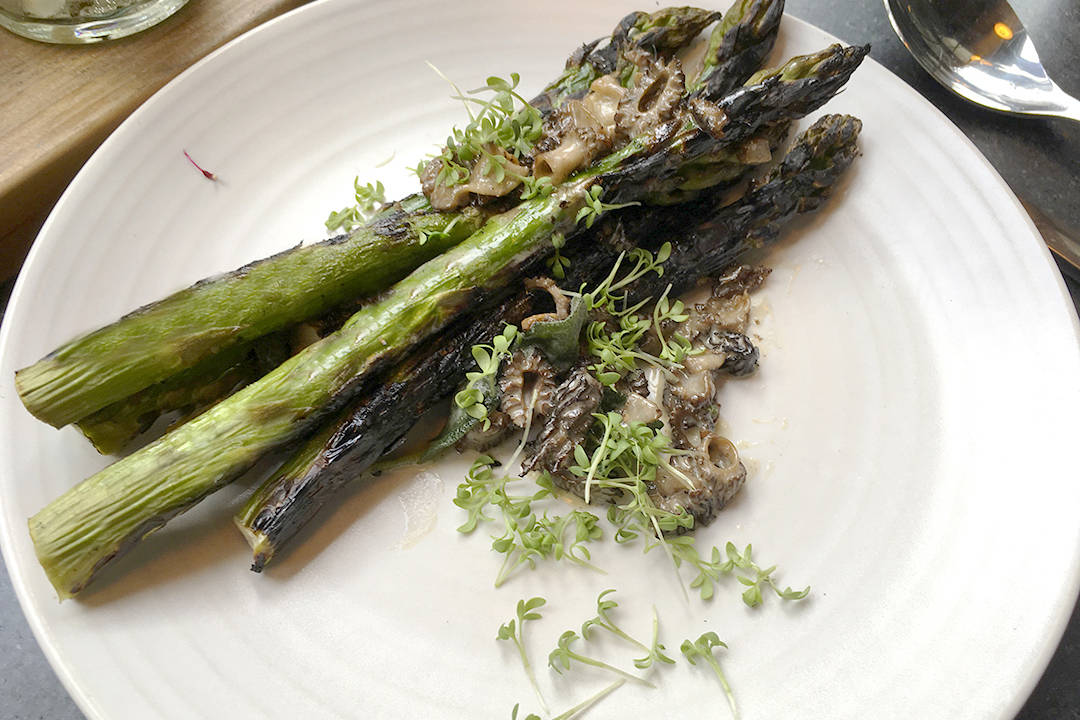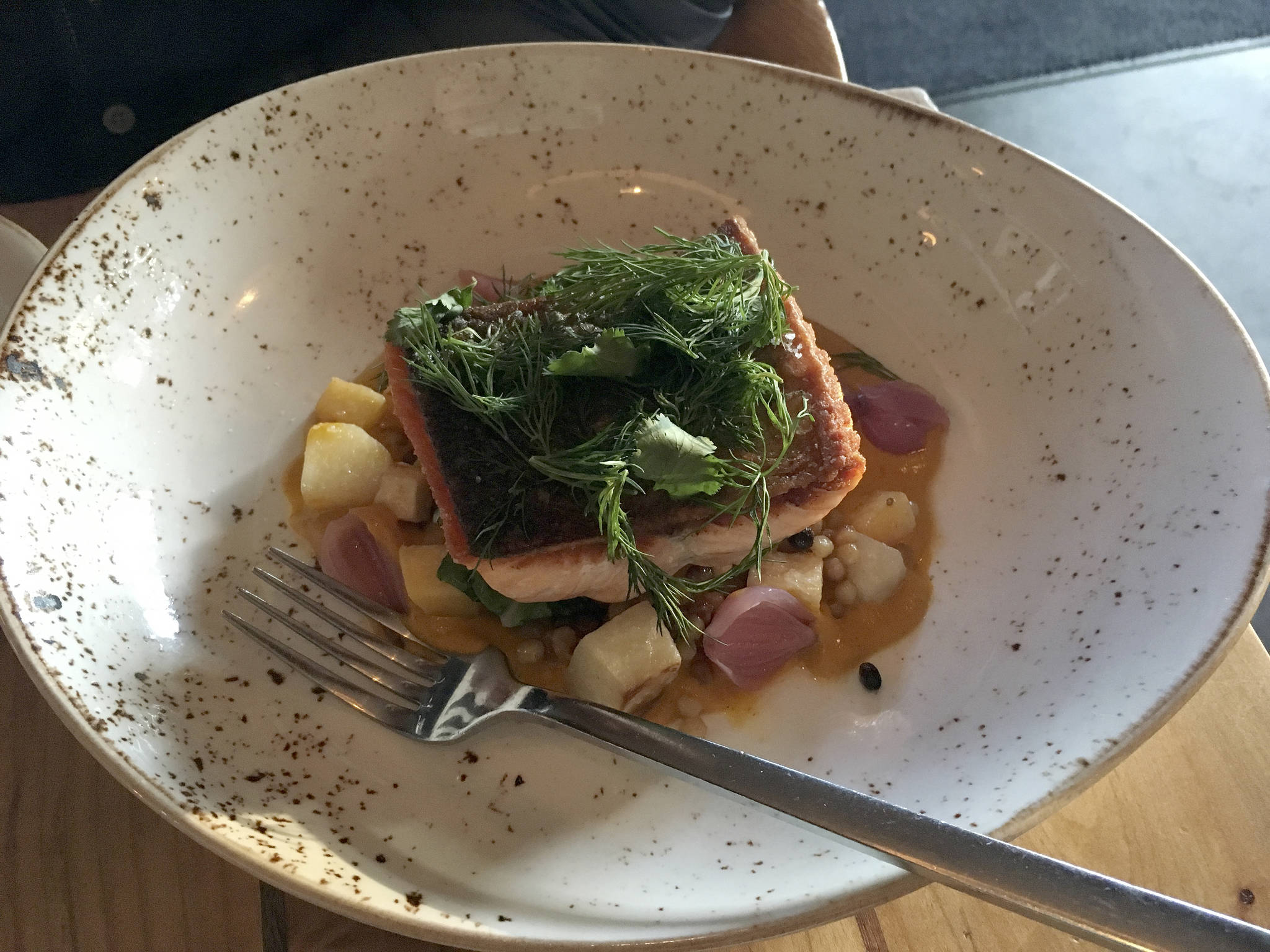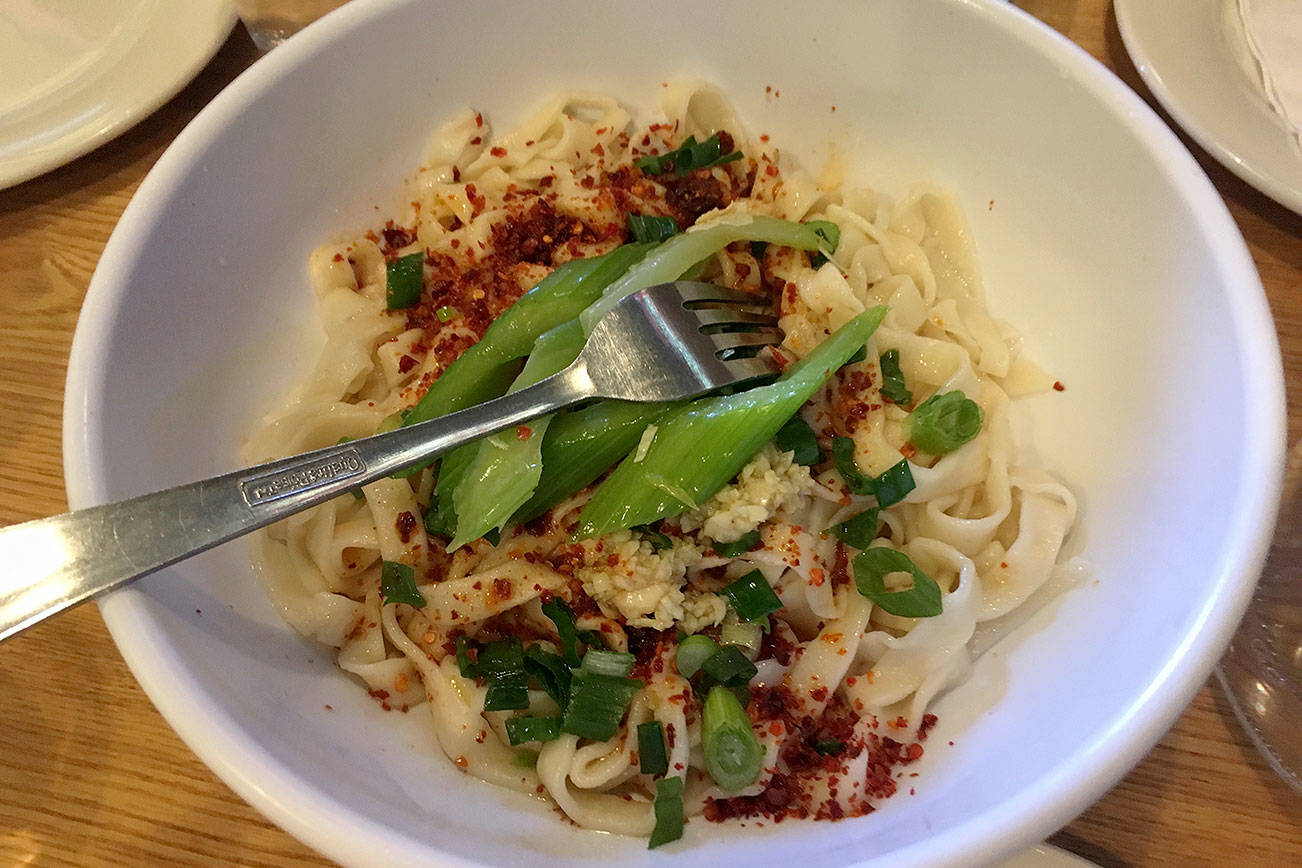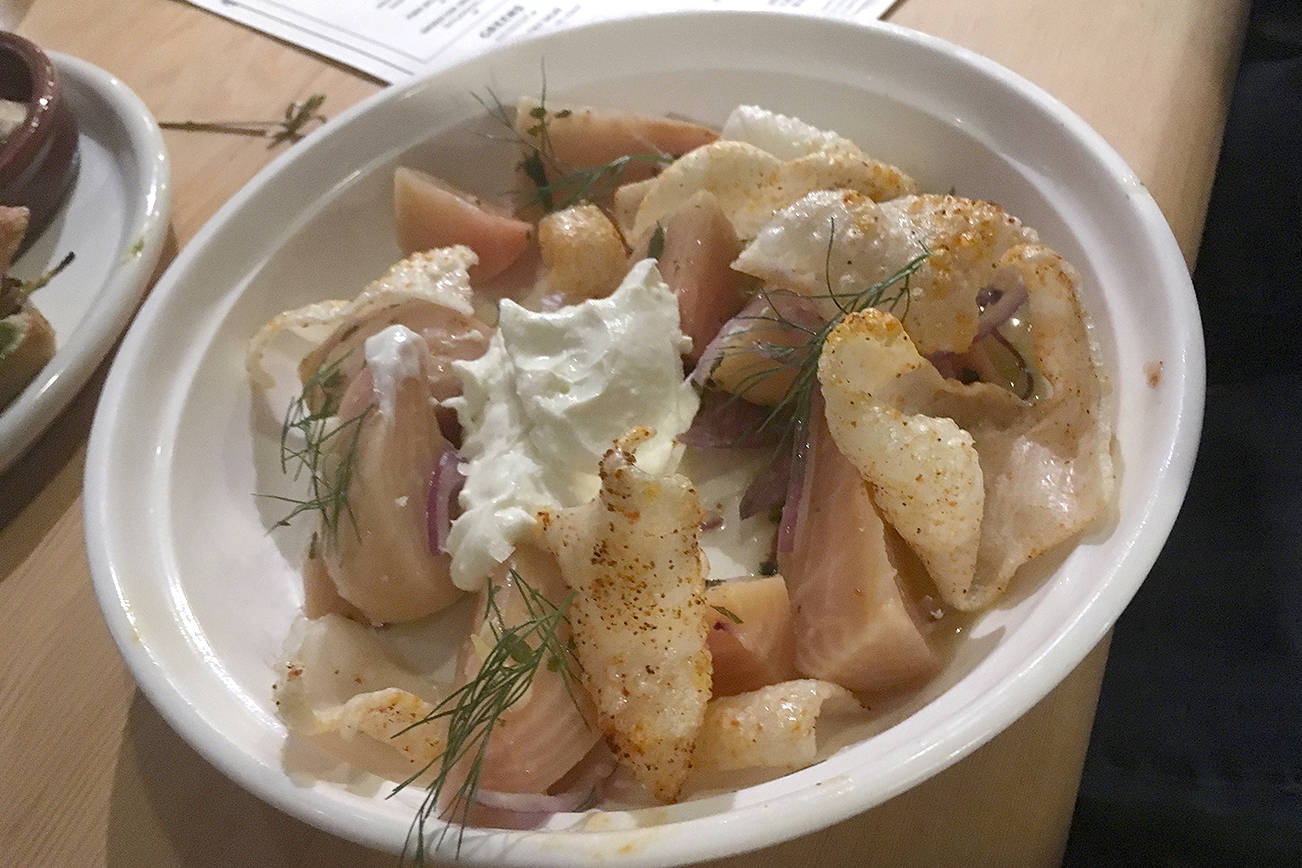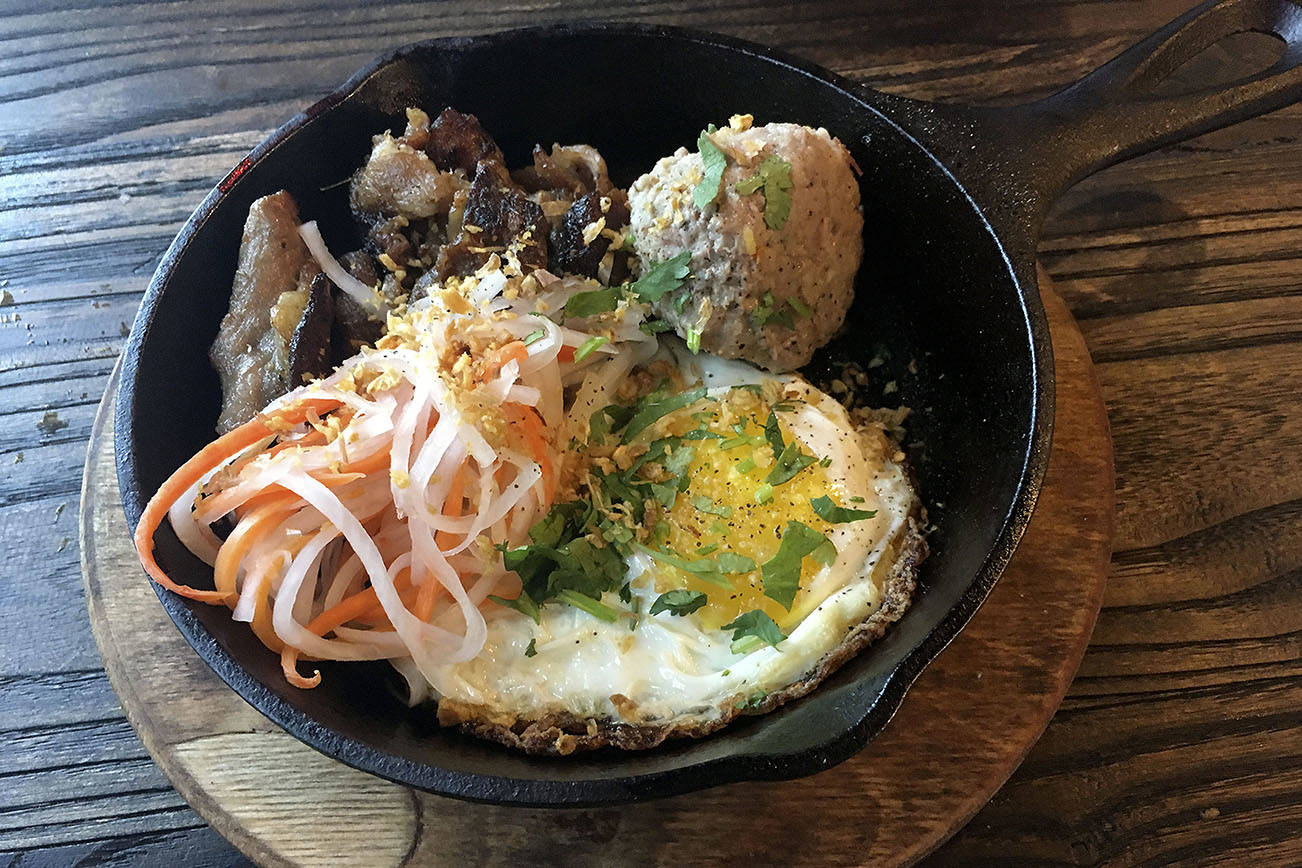I’m a sucker for an intriguing light fixture. So the moment I walked into Marmite (1424 11th Ave., 755-8606) I instantly fell in love. The centerpiece of the large and lovely space, which once housed Erika Burke’s Chop House, is a delicate rendering of a fishing net, loosely hung and dripping with tiny crystals. It adds just the right amount of bling and beauty to the otherwise rustic space with its exposed wooden rafters, finely crafted, blocky tables, and a seemingly freestanding arched white antique shelving piece that holds bottles of liquor. Plants look down from the upper balcony, and tables (communal and two-tops) are topped with gorgeous flowers. It’s prime real estate, enclosed within the shell of the Chophouse Row building, with views that look out onto the promenade. There’s a Matt Dillon feel to it, though I wouldn’t call it derivative.
Not only is its location a nod to Seattle history; the restaurant’s owners, Bruce and Sara Naftaly, are pioneers of the Pacific Northwest dining scene, having operated the former high-end Le Gourmand for 27 years as well as the late Sambar. Both were beloved institutions, so longtime Seattleites will be tickled that the couple is back in business at Marmite. Sara first opened a pastry shop, Amandine, last year in Chophouse Row and continues to operate that while Bruce focuses on Marmite.
Marmite opened several months ago, with lunch only and a concept that revolved around soup. Dinner debuted only recently, and originally consisted of a small, upscale menu with prices to match—but as of last week, the kitchen has pivoted and rethought the whole menu. The result is plates for $15–$20 less, though still in the finer-dining category, with inventive dishes that highlight the local and seasonal but engage a French sauce sensibility.
Though soup doesn’t dominate the dinner menu, there was a variety on offer, so I figured I’d better try it. Though radish soup finished with radish-top pesto and rosewater sounded intriguing and is a pretty shade of peachy-salmon, I couldn’t detect the flavor of radish or even the rosewater. It’s delicious in the way any well-made cream-based soup can be, but it could be cream of cauliflower or potato. A simple plate of asparagus and morels is plentiful, the thick stalks of asparagus charred and still meaty and yielding inside—but they’re stingy with the morels, and the morel ragout it’s purported to come in is more like a few drops, albeit delicious. It’s essentially an $18 plate of asparagus.
From those “small” items, we moved on to “medium” and a simple plate of blintzes, folded up into pockets that give the dough a thicker, heartier feel; filled with Kurt’s fresh, tangy Farmhouse cheese; and finished with a chive-butter sauce. It’s elegant comfort food. Also from that section of the menu was a judiciously cooked piece of pine-smoked trout, its pearly pink flesh tender beneath a layer of crisped, seared skin. Alongside it comes a small pool of mugolio sauce vin blanc with pine nuts—a white-wine sauce that’s thickened with a butter-flour mixture and, in this case, seasoned with pine. It has a sweetness that helps balance the saltier trout, but the spinach, sorrel, and cilantro crushed potato that comes with it felt like it belonged on another plate. On its own, it was interesting (though lacking in salt to really bring out all those vegetal, herbal flavors). Served with, say, the asparagus and morels instead, it would be a perfect plate.
There are only three “larger” entrées to choose from, and, curious as I was about the grilled lamb-tongue brochettes, we went with the more approachable pork boulettes (meatballs) spiced with an arum (wild ginger) lime zest, and markrut lime leaf over curry-coconut spaetzle. Those flavors could have easily overpowered but, if anything, they’re actually a bit too shy—which results in a one-note quality that was slightly disappointing. Most of the flavor comes from the spaetzle, those tiny, delightful German and Austrian soft egg noodles that I adore. This dish epitomized the whole experience for me: obvious care and thoughtfulness in the planning and execution, but lacking that extra something to turn it into a truly memorable meal. In all fairness, this is a brand-new menu, and based on the competency of the Naftalys, I’m excited to see it evolve.
Just like the food, the cocktail menu strives to be unique, particularly with a $14 drink called The Scholar that we waited 40 minutes for, as the housemade coconut rice milk component was cooling. When we did finally get it, our expectations were likely too high; the Suntori Toki Whiskey, as well as the rice milk and the spiced pistachio powder, were severely overshadowed by lime. What should have been a subtle, sweet-spicy cocktail that highlighted the expensive Japanese whiskey tasted more like a margarita. I did love my Strangler, though, a marriage of beer and sparkling wine, specifically a saison reduction with cava, aquavit, bergamot, and lemon. It’s bubbly, cheerful, and still sophisticated—essentially the vibe of the restaurant. In fact, our soft-spoken, kind server took The Scholar off the bill since it took so long to prepare and thanked us for bearing with them on the first night of their menu overhaul. This gesture came from the heart—just like everything the Naftalys touch.
nsprinkle@seattleweekly.com
